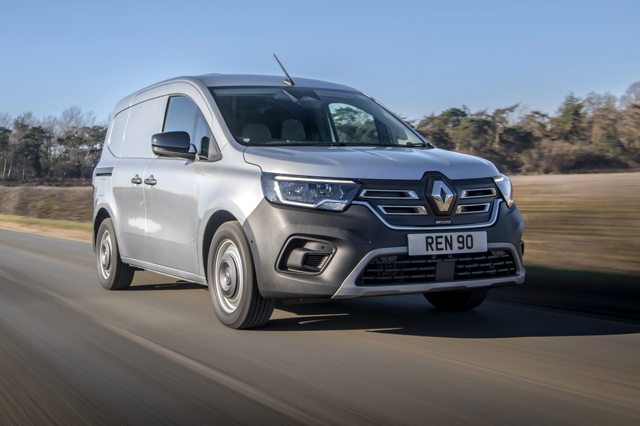Renault Kangoo E-Tech Review 2025
Renault Kangoo E-Tech At A Glance
The original Renault Kangoo Z.E was a trailblazer back in 2017, but the latest Renault Kangoo E-Tech was long overdue when it arrived. Do key small van rivals now offer a more compelling package? Read our Renault Kangoo E-Tech full review to find out.
In terms of its appearance, the Renault Kangoo E-Tech certainly scores well. It’s a little smaller than the likes of the Citroen e-Berlingo, Stellantis’ French sister van the Peugeot e-Partner and Britain’s Vauxhall Combo Electric, but it’s smart, stylish and functional.
Bold C-shaped headlamps and a lower and wider stance than we’ve seen before help it stand out. It also has a much more refined and technologically advanced cabin, with a car-like feel and comfortable seats.
Sadly, though, UK versions of the Renault Kangoo E-Tech aren’t as advanced as their European equivalent models.
In left-hand-drive markets, the Renault Kangoo in all its forms has a clever swivelling bulkhead with a load-through option, but this isn’t offered on right-hand-drive models.
The rival Stellantis vans from Peugeot, Vauxhall, Citroen – plus, of course, the Fiat e-Doblo – boast more load functionality and are bigger, as well as having a longer-range battery option.
So if you need the extra functionality, then the Renault Kangoo E-Tech might not be the best choice for you. That said, it’s a great-value van that’s good to drive.
There are two trims available – Start and Advance – and there are two load lengths, including a crew cab option on the longer model.
Of the two, the bigger van has the higher payload due to a heavier duty rear axle, meaning it’ll take a 764kg payload, compared with 608kg for the shorter van. Both are below the 803kg payload of the Stellantis models.
Only one battery/power source combo is on offer – a 45kWh lithium-ion battery with a range of up to 186 miles. The power unit is a 90kW electric motor with 82PS, or just 61PS in Eco mode.
The standard warranty, meanwhile, is three years or 100,000 miles, with the battery covered up to eight years and the same mileage.
Driving the Renault Kangoo E-Tech
There’s only one battery and motor combination in the Renault Kangoo E-Tech, but the good news is it’s extremely smooth and surprisingly responsive, given its modest power output.
It’s progressive rather than swift, but you’re only going to get the maximum range of 186 miles in slower Eco mode, with Normal reducing it by as much as 20 per cent.
There are, however, three different brake regeneration settings. These are adjusted via the gear lever and will bring the van to a near standstill in the most powerful setting, although you’ll still need to put your foot on the brake pedal to stop it completely.
Of particular appeal will be the built-in fast-charging function, which will accept a supply of up to 80kW.
With a DC charger, you can take the battery from 20-80 per cent capacity in just 40 minutes, while 22kW AC charging takes an hour and 21 minutes to replenish to a similar amount.
An overnight charge via a domestic supply will take around 13 hours.
One of the standout features of the Renault Kangoo E-Tech is its standard heat pump, which takes load off the battery to warm the cabin. You can even use the pump to warm the van’s cab via Renault's smartphone app before leaving the house.
Otherwise, it’s a very comfortable van with excellent refinement, well-suppressed road noise, good visibility and a wide range of safety and driver assistance systems available.
Renault Kangoo E-Tech interior
The Renault Kangoo E-Tech comes with two lengths and wheelbases. The shorter van is a compact 4.5 metres long and the larger model measures 4.9 metres, and they are known respectively as ML and LL.
Both models have twin rear doors, split 60:40 asymmetrically, while the LL has twin side loading doors.
The shorter van only has a sliding door on the nearside, while the crew cab option is restricted to the longer van.
The payload on both versions is less than in the non-electric Renault Kangoo models – a modest 608kg for the smaller model and 764kg for the long one, which has a heavier-duty rear axle.
The load bay is well laid out, though, with a decent 1806mm of load length in the shorter model and 2230mm on offer in the bigger one. There’s a maximum load width of 1570mm and 1248mm between the wheelarches on both.
The maximum loading height, meanwhile, is 1115mm through the door aperture and 1215mm in total.
Up front, the cabin is smart and neatly laid out in both trim levels, and there’s an eight-inch touchscreen, DAB and smartphone integration in each.
The plusher Renault Kangoo E-Tech Advance model gets a double passenger seat and Renault’s Flex wheels, which look like alloys, but aren’t.
Many of the switches and controls along with the steering wheel are shared with the Renault Clio, but this is no bad thing as everything is well made and looks smart.
Storage is impressive in the front, with an overhead shelf, dash top tray, a large glovebox and a useful additional storage cubby above the instrument panel.








:no_upscale():format(webp)/https://cdn.uk.prod.group-mobility-trader.com/images/cas/c12d5371d593a599678c7173efd04a27/5d6a381182af211e6ddedb908129665b.jpg)

 Good to drive. Stylish. Competitive range and pricing.
Good to drive. Stylish. Competitive range and pricing.
 Limited choice of versions. Only one battery option. Limited payload.
Limited choice of versions. Only one battery option. Limited payload.
:no_upscale():format(webp)/https://cdn.uk.prod.group-mobility-trader.com/images/cas/5b4330706d480abac5f79e0a5bb8c339/219c1467a9f618274c60e983ba449067.jpg)
:no_upscale():format(webp)/https://cdn.uk.prod.group-mobility-trader.com/images/cas/c12d5371d593a599678c7173efd04a27/5d6a381182af211e6ddedb908129665b.jpg)
:no_upscale():format(webp)/https://cdn.uk.prod.group-mobility-trader.com/images/cas/ea71d9304d5b9c82a914bd2e750b6995/4c8dadd549ec713dd9d411261b296eea.jpg)